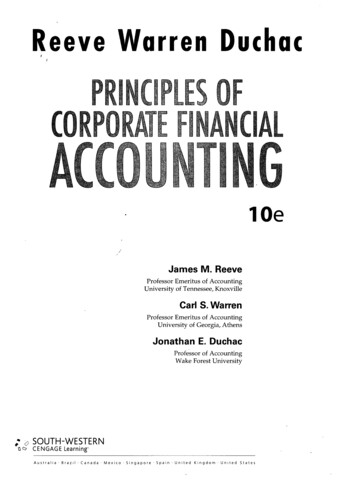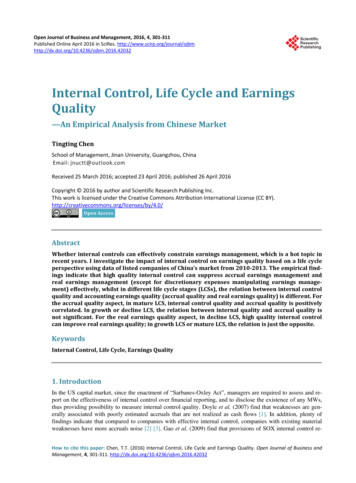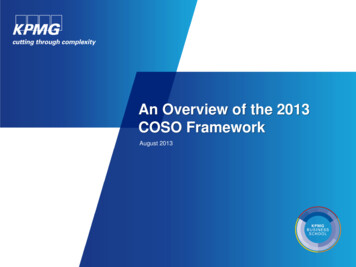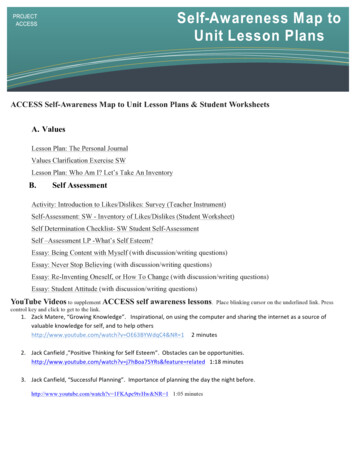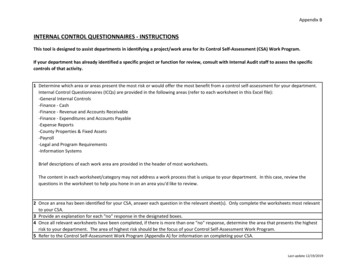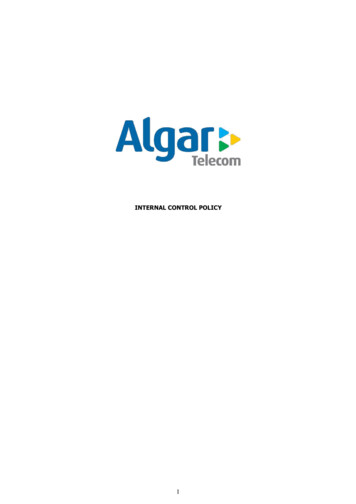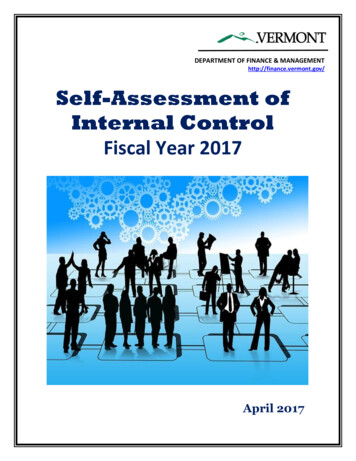
Transcription
DEPARTMENT OF FINANCE & nt ofInternal ControlFiscal Year 2017April 2017
Department of Finance & ManagementFY 2017 Self-Assessment of Internal ControlTable of ContentsPageCommissioner’s Message .3Mission Statement and References 4Internal Control Overview .5Questionnaire Instructions 6–7Self-Assessment Questionnaire:Procurement & Accounts Payable .8 – 14Accounts Receivable & Cash Receipts .15 – 16Fixed Assets .17Inventory .18Grants Administration. .19Budgeting .20General Elements . 21 – 23Certification Form .Page 2 of 2424
.State ofVermontAgency of AdministrationDepartment of Finance & Management109 State Street, Pavilion BuildingMontpelier, vr 05609-0401finance.vermont.govAndrew Pallito, Commissioner[phone] 802-828-2376[fax] 802-828-2428To:· Secretaries, Commissioners, Elected Officials, and DeputiesFrom:Andy Pallito, CommissionerDate:April 2017Subject:FY 2017 Self-Assessment of Internal Control(}jJJ:,O1/Let me begin by welcoming all new members of the Executive Branch and I look forward to working with all of you onGovernor Scott's priorities to grow the state's economy, make Vermont more affordable, protect the most vulnerable,and restore faith and trust in government. As chief executives, we are accountable for ensuring the resourcesentrusted to us are used effectively, efficiently and adequately safeguarded against fraud, waste and abuse; a keycomponent to meeting this objective is through strong internal controls. Next week my office will be issuing the FY2017 Self-Assessment of Internal Control to your business offices for completion by May 8, 2017. For many, this willbe your first exposure to the Self-Assessment but in now its 13th year this should be an established process within yourorganization. The Self-Assessment questionnaire provides departments with a management tool to review, assess anddocument current control practices, identify potential areas of risk or non-compliance, and ultimately be a catalyst forstrengthening each departments' internal control system.How can you help? The overall effectiveness of il)ternal control, including the self-assessment, is greatly influenced byour collective leadership, attitude and commitment to it. Setting the proper tone begins with managers at all levelsdemonstrating their unwavering support of internal controls through their words and actions, and by motivating andguiding employees to produce high-quality work, meet deadlines, adhere to prescribed policies and procedures, timelycommunicate information to those that need it, promptly resolve errors or problems, and protect the State's assetsfrom fraud, waste or abuse. Additional information on internal controls, including a Standards Guide for Managers,can be found on Finance & Management's website at: /internal controls.I'm fortunate to have worked with so many dedicated employees and I prescribe to the viewpoint that our staffs wantto do the right thing, be successful, and take pride in the quality of their work. I recognize many business officesalready feel stretched thin (in terms of what's expected of them), but I believe the time spent completing the self assessment pays dividends down the road. When operational errors and breakdowns occur, they can be significant,time-consuming, costly, and demoralizing disruptions, that pull resources away from our core missions. An objective ofthe self-assessment is to minimize those undesired events through informed, competent staff and robust internalcontrols, and when that happens, then the better outcomes we can achieve within our departments and as a State.I ask for your support in endorsing the Self-Assessment of Internal Control within your department and ensuring thatthe questionnaire responses are a valid representation of your operations. The responsibility for certifying the Self Assessment resides solely with the appointing authority and cannot be delegated to deputies or other positions. Pleaseensure the questionnaire is completed, reviewed, certified and returned to the Department of Finance & Managementby no later than May 8, 2017, thank you.Page 3 of 24
FY 2017 Self-Assessment of Internal ControlMission StatementThe mission of the Internal Control Section is to provide State agencies and departments the objective resources,guidance and recommendations to improve the State’s financial operations and system integrity. Through acombined effort of evaluation, communication, cooperation and education, we will work toward improvingoperational efficiency, enhancing internal controls and ensuring compliance with published bulletins, policies andprocedures.References & AcknowledgementsThe Vermont Department of Finance & Management would like to credit the Committee of SponsoringOrganizations of the Treadway Commission (COSO) and various State governments and institutions of higherlearning for portions of the material contained in this document.Page 4 of 24
FY 2017 Self-Assessment of Internal ControlInternal Control OverviewDefinition: Internal Control is a process integrating the activities, plans, attitudes, policies, and efforts of the peopleof a department working together to provide reasonable assurance that the department will achieve its objectivesin the following categories: Operations - Effectiveness and efficiency of operations, including operational and financial performancegoals, and safeguarding assets against loss;Reporting – Reliable and timely internal and external financial and non-financial reporting;Compliance – Adherence to applicable laws and regulations.Fundamental Concepts of Internal Control: Geared towards the achievement of objectives, affecting every aspect of a department its people,processes and infrastructurePeople-dependent, effectiveness based upon the action, attention and attitude of people at every level ofthe departmentCost-effective and adaptable to each department’s operating environment(s)Process consisting of ongoing tasks and activities woven into the day-to-day activities and responsibilitiesof managers and staff – a means to an end, not an end in itselfProvides reasonable assurance regarding the achievement of objectives, but not absolute assuranceCOSO’s Five Interrelated Components:Control Environment: The control environment sets the tone of the department and influences the effectivenessof internal controls. Control environment factors include the ethical values and integrity of the people,management’s philosophy and operating style, a commitment to competence, and the organizational structure ofthe department.Risk Assessment: Risk assessment is the identification, analysis, and management of risks relevant to theachievement of the department’s goals and objectives. Risks include internal and external events or circumstancesthat may occur and adversely affect the department’s operations.Control Activities: Control activities are the policies, procedures, and practices that help ensure managementdirectives are carried out. Control activities help identify, prevent or reduce the risks that can impedeaccomplishment of the department's objectives. They include a range of activities as diverse as approvals,authorizations, separation of duties, documentation, reconciliations, supervision, and safeguarding of assets.Information and Communication: Pertinent information must be identified, captured and communicated in aform and timeframe that enables people to carry out their responsibilities. Effective communication also must occurin a broader sense, flowing down, across and up the department.Monitoring: Internal controls systems need to be monitored to assess the quality of the system’s performanceover time. Monitoring occurs during the course of normal operations and through separate evaluations and includesreview of the department’s activities, systems, and transactions to determine whether controls are effective. For more information refer to the following publication on the Dept. of Finance & Management’swebsite: Internal Control Standards: A Guide for Managers.Page 5 of 24
FY 2017 Self-Assessment of Internal ControlQuestionnaire InstructionsThe Self-Assessment of Internal Control Questionnaire is a review of the internal policies and procedures in eachdepartment. The questionnaire is designed to help you identify risk and eliminate considerations of risk that do notapply to your department. The questionnaire serves as management tool for your department in evaluating how wellrisks are being addressed through current control policies and practices. It is designed to raise awareness of certainissues and encourage further analysis and discussion. The questionnaire will also help the Department of Finance &Management identify best practices to share with departments.The questionnaire may be completed either in PDF (fillable form) or Excel with an option for the Appointing Authorityto electronically certify and submit via email. If electronic certification (Excel or PDF) is used, (1) the box on thecertification form must be checked and (2) the file must be submitted directly from the appointing authority’s emailaccount. [Note: Email submissions from delegates (re: On Behalf of) are not permitted.] IMPORTANT: The certification (signature or electronic) must be completed by the AppointingAuthority (i.e., Secretary, Commissioner) and cannot be delegated to Deputies or other positions.The Department of Finance & Management requires that the questionnaire be completed, certified by the appointingauthority, and returned by Monday, May 8, 2017 to:Kevin GilmanDept of Finance & ManagementFinancial Operations Division – 4th Floor109 State Street, Montpelier, VT 05609-5901Email: kevin.gilman@vermont.govThe questionnaire consists of 7 sections and 212 questions; not all sections will be applicable to every department:1. Procurement and Accounts Payable - 91 questions Purchasing activities, invoice processing, petty cash, and employee payroll & expenses. Note: Net increase of 5 questions 7 added (2 for Purchasing and 5 for Employee Payroll & Expenses)and 2 removed (1 each from Purchasing and Employee Payroll & Expenses)2. Accounts Receivable and Cash Receipts - 30 questions Treatment of revenue and amounts owed the State, the handling of cash receipts (currency & checks),and the management of external bank accounts.3. Fixed Assets - 18 questions Management and accounting treatment of fixed assets.4. Inventory - 9 questions Control and tracking of significant inventories; does not apply to items such as office supplies,computers, or fixed assets.5. Grants Administration - 10 questions Compliance issues pertaining to grants and AOA Bulletin 5: Policy for Grant Issuance & Monitoring.6. Budgeting – 6 questions Best practices pertaining to the budget process.Page 6 of 24
Self-Assessment Instructions7. General Elements of Internal Control* – 48 questions Five interrelated components of internal control as identified by the COSO model: Control Environment– Risk Assessment – Control Activities – Communication & Information systems – Monitoring. Note: 1 new question for Control Activities* This section should be answered from a department-wide perspective.In completing this questionnaire we expect you to consult with other members of your department in order toprovide as comprehensive and accurate responses as possible. Responses should be based upon current practices,not on what the department thinks the answer should be, and not on what the department intends to implement inthe future. For the purpose of this questionnaire, “Department” means any discrete agency, department, office,board or other administrative unit with a designated general ledger business unit number. We strongly recommenda single unified response for each department. However, if there are smaller discernable areas within yourorganization with separate and distinct operations, you may complete multiple questionnaires as appropriate; pleaseidentify those discernable areas on each response.Questions are phrased so that a “YES” answer indicates a control strength and “NO” answer indicates a possibleweakness. It is not expected that a questionnaire will have all “YES” answers even if internal controls are adequatelyaddressed. Answering many of the questions will require professional judgment and we recognize that a “YES”answer does not imply absolute assurance. Following are some guidelines to keep in mind when completing thequestionnaire: Please try to limit the response of “N/A” to only those questions that are clearly not applicable to yourdepartment; just because the control activity referenced in the question is not in place in your department,does not necessarily signify that the question is not applicable. For questions that pose “Does the department have written procedures ” only respond “YES” where thereare department specific written procedures; do not answer “YES” if you are only referring to a statewidepolicy (e.g., F&M Policies, VISION Procedures, AOA Administrative Bulletins, etc.). To assist departments with completing the questionnaire, hyperlinks have been added to many questions tofacilitate review of referenced documents or websites. In responding to the questions we recommend using the following criteria:YES:When the issue addressed is widely in place throughout your department.NO:When the issue addressed is not in place or only in a very limited scope.NA:Use only when the issue addressed is “not applicable” to your department.Note: Questions answered “YES” and “NO” will be marked “NO” for compilation & scoring purposes.If you have any questions regarding this Self-Assessment questionnaire, please contact the following individuals atthe Department of Finance & Management:Kevin Gilman, VISION Operations Analyst IV; e-mail: kevin.gilman@vermont.govAndy Pallito, Commissioner; e-mail: andy.pallito@vermont.govPage 7 of 24
FY 2017 Self-Assessment of Internal Control QuestionnaireDepartment:If completing in Excel, use the drop-down box in the appropriate column to select/change your response.YESNOSection 1: Procurement & Accounts PayableNAPurchasingDoes the department have written procedures regarding the initiation, review, and1 approval of all purchases (goods & services)? [Note: Procedures should address theentire purchasing cycle including the front-end steps to initiate and authorize a purchase, as well asinvoice processing after the purchase has been made.]2Are procedures established to identify, before funds are committed, costs andexpenditures not allowable under federal/state grant programs?When making purchasing decisions does the department rely on the guidanceprovided by the BGS-Office of Purchasing & Contracting's Buyers Resource3Guide to help ensure compliance with applicable laws and administrativerequirements?Before executing a contract, does the department obtain all required prior4 approvals as stated in AOA Bulletin #3.5: Procurement and ContractingProcedures?Are all departmental contracts, regardless of amount, entered in VISION in5 accordance with Bulletin #3.5 (unless exempted by the dept's contracting planapproved by the Secretary of Administration )?For each departmental contract, does the department maintain an up-to-date6 contract file that includes all documents required by Bulletin #3.5 and that isretained for a minimum of three years after the expiration of the contract?Before executing a contract or contract amendment, does the department ensure7 that the then current version of Attachment C (Standard State Provisions) is usedas required in AOA Bulletin #3.5?When acquiring goods or services, does the department initially determinewhether the items are available through a statewide contract or, if not, are they8covered under a blanket delegation of authority (BDA)?Note: Statewide contracts & BDAs are issued by BGS-Office of Purchasing & ContractingWhen items to be purchased are available through a statewide contract, does the9 department always utilize the statewide contract (unless otherwise approved bythe Office of Purchasing & Contracting ) in accordance with Bulletin #3.5?Does the department comply with the BDA requirements for utilization, reporting,10 and VISION data entry requirements (re: BDA Quick Step Guide) as prescribed byBGS-Office of Purchasing & Contracting?Is the department aware BDA-1 is primarily for the purchase of goods /suppliesnot available by contract (and under specific conditions ), and, is not to be used11for items such as personal services, utility payments, lodging, meals, postage,membership fees, rental space, payments to other departments, etc.?12Does the department comply with the purchasing, contractual, and grantagreement requirements specified in F&M Policy #1: Suspension and Debarment?Page 8 of 24
YESNOSection 1: Procurement & Accounts PayableNAAre receiving reports or other procedures used to ensure that goods or services,13 for which payment is to be made, have been verified and inspected by someoneother than the individual approving payment?Does the department always use purchase orders when making payment against14 a contract (including statewide contracts) in accordance with VISION Procedure#3: Purchase Orders?15Is the splitting of orders, to avoid higher levels of approval (e.g., BDA-1),prohibited?16Are purchases of "personal" greetings or acknowledgments prohibited inaccordance with F&M Policy #3: Personal Greetings/Acknowledgments?Does the department ensure that all “food” purchases (e.g., direct payment, P17 Card, expense report, petty cash) are in accordance with the requirements of F&MPolicy #4: Department Provided Food & Refreshments?In accordance with AOA Bulletin 3.4: Employee Travel & Expense Policy, does thedepartment prohibit* payment for any employee professional or occupational18 licenses? [*Unless specifically allowed under Bulletin 3.4, collective bargaining agreements orwith the prior approval of the Commissioner of Human Resources based on a valid & binding pastpractice.]19 Is proper control maintained over vendor credit memos and returns of goods?For fuel purchases, does the department utilize State contract vendors and verify20 the accuracy of invoices using the fuel pricing information ('rack mark-up')maintained by BGS-Office of Purchasing & Contracting?21 Does the department utilize the State of Vermont's Purchasing Card (P-Card)?22Does the department reconcile the P-Card billing statement to original sales slips,invoices, register receipts or purchasing card slips?Invoice Processing23 Are all invoices received in a central location, such as the accounting unit?24 Are invoices date stamped upon initial receipt?25Are all invoices reviewed and approved (i.e., signed or initialed) by an authorizedperson prior to voucher entry in VISION and payment?Does the business office maintain an up-to-date listing of specific employees/positions who can authorize purchases & approve invoices (including any26limitations to their authority )?Note: This question does not pertain to VISION voucher approval or security levels.For vendor set-up or maintenance issues, does the department refer to F&M's27 guidance VISION Vendor Set-Up, W-9 Forms and Reportable PaymentProcessing - FAQs?Does the department urge vendors (including contractors & grantees) to enroll in28 Automated Clearing House (ACH) payments as the State’s preferred paymentmethod?Page 9 of 24
YESNOSection 1: Procurement & Accounts PayableNAIs the department aware that the State Treasurer's Office maintains a Vendor29 Portal website for vendors to view information about their electronic payment(ACH or wire) history?Does the department ensure that payables interfaced into VISION from adepartmental sub-system comply with all applicable VISION voucher requirements30including but not limited to purchase orders, contract payments, BDAs, 1099-Miscreportable items, and vendor payment terms?Are payments made only on the basis of original invoices (including electronic31invoices) and to vendors identified on the supporting documentation?When the department finds that vendor address information in VISION does notmatch the vendor address listed on an invoice, are appropriate steps* taken to32ensure the vendor record is updated in VISION prior to payment being issued? [*i.e., W-9 received from vendor, Vendor Request Form submitted to F&M]Do invoice processing procedures provide for detailed examination and33 comparison of invoice quantities, prices, and terms with those indicated on therequisition, purchase order, and receiving reports, as applicable?Does the department adhere to the “one invoice – one voucher” requirement and34 not split a vendor’s invoice into multiple VISION vouchers (except for invoices thatspan fiscal years per VISION Year End Closing Instructions)?If payment for a departmental contract is made without use of a purchase order35 (or the PO is entered without a contract) does the department submit a request toF&M-Financial Operations to adjust the contract balance?36Do invoice processing procedures require all invoices to be fully itemized inaccordance with 32VSA§463?Do invoice processing procedures provide for checking the accuracy ofcalculations, as appropriate?Are invoices and vouchers reviewed and approved for completeness of supporting38documents and chart of account accuracy?37Do departmental procedures generally prohibit the same employee from39 performing all three functions of entering, approving and budget-checking aVISION voucher?When processing invoices for 1099 reportable vendors*, does the departmentensure the accuracy of the reportable and non-reportable line items on the40 "Withholding" page of the VISION voucher?[* For more information refer to the job aid VISION Vendor Set-Up, W-9 Forms and ReportablePayment Processing - FAQs and/or the VISION Accounts Payable training manual - page 81]When processing invoices that pertain to a prior fiscal year, does the department41 enter the "PY" prefix* in the invoice field of the VISION voucher?[* For more information refer to Operational Guidance #4: Prior Year Payables]Except for the “PY” prefix (when applicable ), does the department refrain fromentering any information other than the vendor’s invoice number in the invoice field42of the VISION voucher?(re: to enhance VISION's duplicate payment functionality and vendors' payment posting)Page 10 of 24
YESNOSection 1: Procurement & Accounts PayableNAUnless a valid and documented business reason exists, does the department'sbusiness practices prohibit the changing of the vendor's payment terms on the43VISION voucher to DUE NOW (i.e., NET00-pay immediately)?Note: For more information refer to F&M Policy #5: Payment Terms44Does the department have procedures in place to take advantage of vendordiscounts?Does the department have procedures to minimize the risk of duplicate payments,including instructing AP staff not to alter any of the four key matching criteria (i.e.,45vendor ID, invoice number*, invoice date, gross amount) used for VISION’sduplicate invoice checking functionality? [*except "PY" prefix]Is there a procedure for ensuring that all posted processed vouchers have beenpaid?Are all vouchers and supporting documents retained in accordance with VISION47Procedure #2: Records Retention?46Petty CashDoes the department have a petty cash fund? [Note: This includes any petty or48 imprest cash fund that was established through an advance of funds to support variousoperating and programmatic activities.]If the answer to the above question is "NO" then skip to the "Employee Payroll andExpenses" section below.49 Is one employee assigned responsibility as custodian of the fund?Are petty cash funds only used for allowable purposes in accordance with VISIONProcedure #5: Petty Cash?Does the department have written procedures for the fund (besides VISION51 Procedure #5 ) defining the custodian's responsibilities, primary uses of the fund,timelines, and safeguarding of the fund?Are petty cash funds, including all checks, maintained in a secure location (e.g.,52locking cabinet, desk, or safe) under the control of the custodian?5053Prior to replenishing the fund, is a reconciliation (back to the fund's authorizedamount) performed by the custodian and approved by a supervisor or manager?54Does the department comply with the Check Cashing Procedure for petty cashreplenishments?Are all petty cash funds replenished at least annually (preferably prior to fiscalyear-end)?Is a petty cash log maintained (to include receipts, purpose, reimbursee, date) for56each disbursement?Does the department periodically perform unannounced counts (or reviews) of the57fund by someone other than the custodian?5558 Is there a maximum amount for individual payments from the fund?Page 11 of 24
YESNOSection 1: Procurement & Accounts PayableNAEmployee Payroll & ExpensesDoes the department comply with the requirements of DHR Policy 11.10: Time59 Entry and Approval to ensure the timely & accurate submission and approval ofemployee timesheets?60Are all employee timesheets reviewed and approved by an appropriatesupervisor?For effective timesheet review, does the department provide supervisors adequate61 guidance on the correct use of time reporting codes (TRC), task profiles &combination codes, and adherence to deadlines?62Are changes to a submitted timesheet made by either a supervisor or delegatedocumented in the “Comments” field?63To the extent practical, are overtime hours approved in advance by an appropriatesupervisor?Do supervisors actively monitor employee's leave balances and work with their64 employees to ensure accruals remain at manageable levels and that futurestaffing needs aren't placed at risk?In accordance with the Secretary of Administration's Directive Memo (7/30/14),65 does the department prohibit the use of gift cards (pre-paid credit cards, giftcertificates, etc.) as a form of employee recognition or merit award?In accordance with AOA Bulletin 2.3: State Vehicles Policy (re: Appendix A), foremployees authorized to commute in a State vehicle (e.g., "take-home vehicle")does the department have procedures in place to capture and report all66commuting that does not meet one of the allowable IRS exclusions to VTHR as ataxable employee fringe benefit? [Note: Unauthorized commuting and all other personaluse of State vehicles is strictly prohibited by the Bulletin.]Does the department have a process to ensure that all employees (and theirsupervisors) who travel for State business, or incur other reimbursable expenses,67are aware of and familiar with the AOA Bulletin 3.4: Employee Travel & ExpensePolicy?Are all employee expense reimbursements (travel and non-travel, excluding DHR68 Tuition Reimbursement ) processed through the VISION Expense module, not theAccounts Payable module?In accordance with AOA Bulletin 3.4, does the department require completion ofthe “Tuition Assistance Employee Certification” form for all department provided69tuition assistance (direct pay to educational institution or employeereimbursement)?Do departmental procedures ensure the three key roles of employee expensereport processing.1) Employee submission, 2) Supervisor review and approval,70and 3) Expense Coordinator review and final approval.are performed bydifferent people?Page 12 of 24
YESNOSection 1: Procurement & Accounts PayableNAWhen F&M (VISION Support) provides expense coordinators with generalinformation or guidance regarding employee expenses (e.g., "please share with71your employees" ), does the department have a process in place to disseminatethis information to its employees?When reviewing and approving expense reports does the department verify the72 accuracy and completeness of the data including all required receipts andsupporting forms?Does the department have a process to verify that expense reports submitted in73 the VISION Expense module were not paid using a State Purchasing Card (PCard)?Does the department ensure employee meal reimbursement requests areallowable under the applicable collective bargaining agreement and, if so, that74amounts do not exceed maximum reimbursement rates and travel times & meallocations are documented on the expense report?Does the department provide guidance and monitoring of employee mileage75 reimbursements to ensure use of the appropriate full or reduced mileage rate onthe expense report?Per Bulletin 3.4, does the department prohibit the use of employee reimbursementas a purchasing method for non-travel business expenses exceeding 20076(except in emergency situations or with the department head's priorauthorization )?Does the department remind and urge employees to submit their expense reports77 within 20 calendar days of when the travel/expense was incurred, but no lessfrequently than monthly (in accordance with AOA Bulletin 3.4)?78Before approving an expense report does the department verify that, whenapplicable, the employee has copied it from an approved travel authorization?79Before approving an expense report does the department verify that the employeehas applied related and/or outstanding cash advances to the report?For all expense reports submitted more than 60-days after the travel was80 completed or expense incurred, does the department require completion of the“Explanation of Late Filing” form?Do expense coordinators proactively manage expense report submissions and81 approvals throughout the month to minimize the need for deletion of expensereports at month-end (and subsequent re-entry in the following month)?Are supervisors aware that expense reports must be approved within 7 calendar82 days of employee submission or, for planned absences,
FY 2017 Self-Assessment of Internal Control . Internal Control Overview . Definition: Internal Control is a process integrating the activities, plans, attitudes, policies, and efforts of the people

